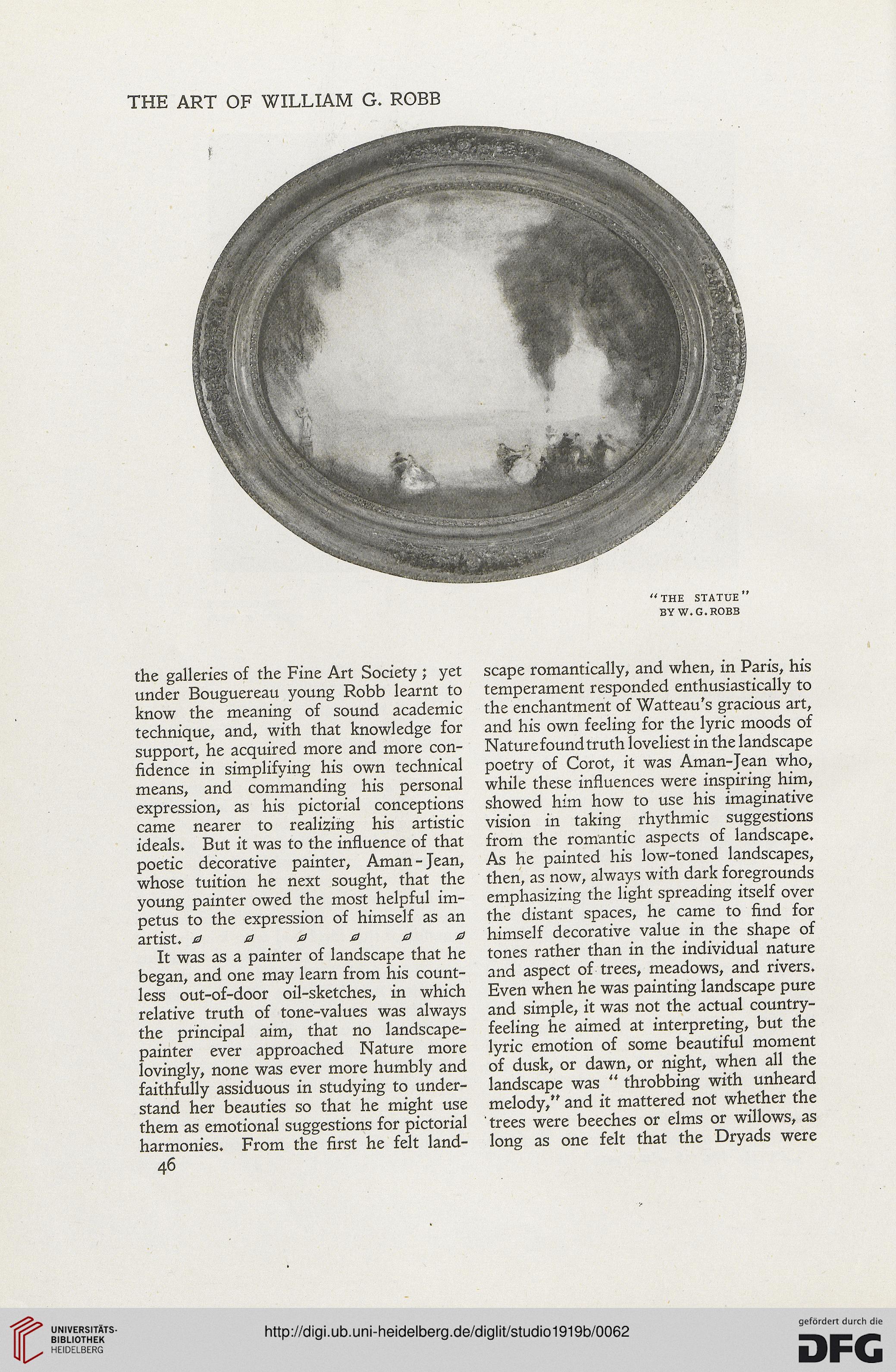THE ART OF WILLIAM G. ROBB
“ THE STATUE”
BY W. G.ROBB
the galleries of the Fine Art Society ; yet
under Bouguereau young Robb learnt to
know the meaning of sound academic
technique, and, with that knowledge for
support, he acquired more and more con-
fidence in simplifying his own technical
means, and commanding his personal
expression, as his pictorial conceptions
came nearer to realizing his artistic
ideals. But it was to the influence of that
poetic decorative painter, Aman - Jean,
whose tuition he next sought, that the
young painter owed the most helpful im-
petus to the expression of himself as an
artist. 00000a
It was as a painter of landscape that he
began, and one may learn from his count-
less out-of-door oil-sketches, in which
relative truth of tone-values was always
the principal aim, that no landscape-
painter ever approached Nature more
lovingly, none was ever more humbly and
faithfully assiduous in studying to under-
stand her beauties so that he might use
them as emotional suggestions for pictorial
harmonies. From the first he felt land-
46
scape romantically, and when, in Paris, his
temperament responded enthusiastically to
the enchantment of Watteau's gracious art,
and his own feeling for the lyric moods of
Nature found truth loveliest in the landscape
poetry of Corot, it was Aman-Jean who,
while these influences were inspiring him,
showed him how to use his imaginative
vision in taking rhythmic suggestions
from the romantic aspects of landscape.
As he painted his low-toned landscapes,
then, as now, always with dark foregrounds
emphasizing the light spreading itself over
the distant spaces, he came to find for
himself decorative value in the shape of
tones rather than in the individual nature
and aspect of trees, meadows, and rivers.
Even when he was painting landscape pure
and simple, it was not the actual country-
feeling he aimed at interpreting, but the
lyric emotion of some beautiful moment
of dusk, or dawn, or night, when all the
landscape was “ throbbing with unheard
melody," and it mattered not whether the
trees were beeches or elms or willows, as
long as one felt that the Dryads were
“ THE STATUE”
BY W. G.ROBB
the galleries of the Fine Art Society ; yet
under Bouguereau young Robb learnt to
know the meaning of sound academic
technique, and, with that knowledge for
support, he acquired more and more con-
fidence in simplifying his own technical
means, and commanding his personal
expression, as his pictorial conceptions
came nearer to realizing his artistic
ideals. But it was to the influence of that
poetic decorative painter, Aman - Jean,
whose tuition he next sought, that the
young painter owed the most helpful im-
petus to the expression of himself as an
artist. 00000a
It was as a painter of landscape that he
began, and one may learn from his count-
less out-of-door oil-sketches, in which
relative truth of tone-values was always
the principal aim, that no landscape-
painter ever approached Nature more
lovingly, none was ever more humbly and
faithfully assiduous in studying to under-
stand her beauties so that he might use
them as emotional suggestions for pictorial
harmonies. From the first he felt land-
46
scape romantically, and when, in Paris, his
temperament responded enthusiastically to
the enchantment of Watteau's gracious art,
and his own feeling for the lyric moods of
Nature found truth loveliest in the landscape
poetry of Corot, it was Aman-Jean who,
while these influences were inspiring him,
showed him how to use his imaginative
vision in taking rhythmic suggestions
from the romantic aspects of landscape.
As he painted his low-toned landscapes,
then, as now, always with dark foregrounds
emphasizing the light spreading itself over
the distant spaces, he came to find for
himself decorative value in the shape of
tones rather than in the individual nature
and aspect of trees, meadows, and rivers.
Even when he was painting landscape pure
and simple, it was not the actual country-
feeling he aimed at interpreting, but the
lyric emotion of some beautiful moment
of dusk, or dawn, or night, when all the
landscape was “ throbbing with unheard
melody," and it mattered not whether the
trees were beeches or elms or willows, as
long as one felt that the Dryads were




